Saturday, August 21, 2004
Æ antoninianus, Gallienus, Siscia, Göbl 1439i
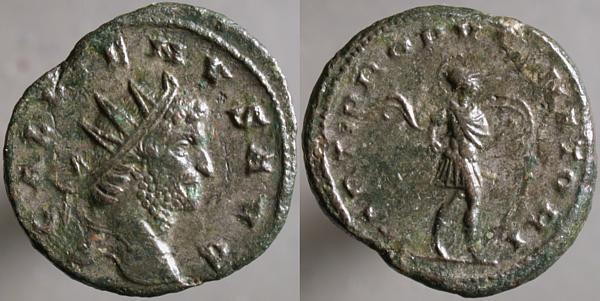
GALLIENVS AVG, Radiate head right | MARTI PROPVGNATORI, Mars advancing right, carrying shield and transverse spear right, cloak flying behind.
From the same mint, and about the same time, as Monday's coin, this is also a design and legend not otherwise used by Gallienus or his father, and I find it far more satisfying than many of the designs that they used repeatedly.
While propvgnatori is related to our "pugnacious", the legend translates as to mars, the defender.
Friday, August 20, 2004
Æ31, Colybrassus in Pisidia, Valerian, SNG von Aulock 5661
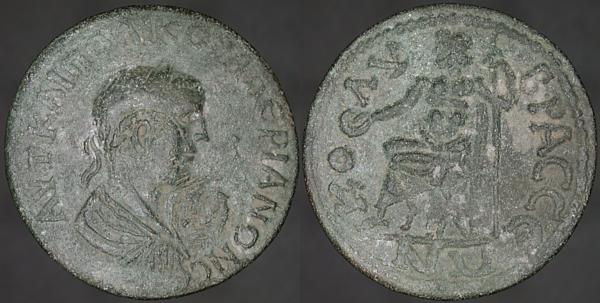
ΑVΤ ΚΑΙ ΠΟ ΛΙΚ ΟVΑΛΕΡΙΑΝΟΝ CΕ, Laureate draped cuirassed bust right, ΙΑ (defaced in antiquity) before | ΚΟ_ΛV_ΒΡΑCCΕΩΝ, Zeus seated left, holding patera left and scepter right.
The entry in von Aulock clearly shows an IA before the bust, not countermarked but from the die. Why it was removed from this example isn't clear. The marks before the bust on coins of this era are understood to be marks of value, in Greek numerals: an Ε indicates five assaria, Ι ten, ΙΑ eleven, and so on. It's clear that some cities were able to use the same obverse dies for two denominations by cutting one value into the die and counterstamping coins, over that denomination, with another.
But someone just scraped the ΙΑ off of this, at some effort.
Thursday, August 19, 2004
Silvered Æ antoninianus, Gallienus, Cyzikus, Göbl 1535Ac
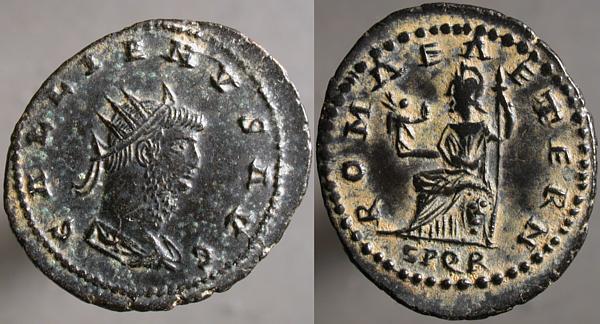
GALLIENVS AVG, Radiate draped cuirassed bust right, no pellets beneath | ROMAE AETERN, Roma seated left on gorgon-face shield, holding spear right and Victory presenting wreath left. SPQR in exergue.
I've mentioned before that imperial issues from Cyzikus, that began very near the end of Gallienus's reign, are of particular interest to me. They're often seen with silvered surfaces which this example lacks, but rarely seen as well-struck and well-preserved as this.
This personification of Eternal Rome was used frequently on imperial coins at this time, and later influenced the depictions of Britannia on UK coins, and of Liberty on US coins.
Update: Fixed link to gorgon-faced shield detail.
Wednesday, August 18, 2004
Billon tetradrachm, Alexandria, Claudius & Messalina, Emmett 74(3)
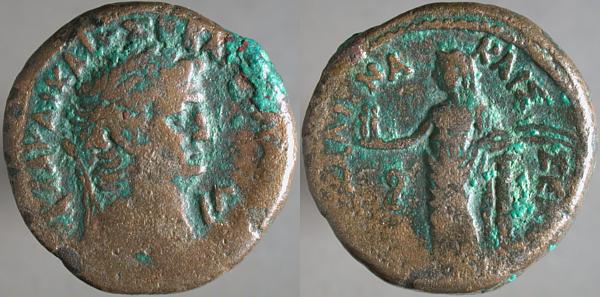
ΤΙ ΚΛΑΥΔΙ ΚΑΙΣ ΣΕΒΑ [ΓΕΡΜΑΝΙ ΑΥΤΟΚΡ], Laureate bust right, LΓ in right field | ΜΕΣΣΑΛΙ_ΝΑ ΚΑΙΣ ΣΕΒΑΣ, Messalina standing facing, head left, holding two tiny figures in her palm left, leaning on column right.
Distressed to find that I've already posted my obol of Claudius with the cool hippopotamus reverse, I remembered this coin, also from Roman Egypt, showing both the emperor and his third wife, Valeria Messalina.
If Messalina's reputation remains badly stained, Tiberius Claudius Drusus Nero Germanicus became a sympathetic figure with the publication of Robert Graves's historical novels, and particularly with the broadcast of BBC's I, Claudius television treatment of them. That miniseries did not mention, for instance, his fondness for sitting down front in the splatter zone at gladiatorial contests. Still, compared to his predecessor and his successor, Claudius was no worse than a run-of-the-mill monster.
On 12-13 October, 54 CE, after 13 years as emperor, he died (at, perhaps, the hands of his fourth wife, or her chef), and his step-son Nero became emperor.
Tuesday, August 17, 2004
Æ30, Perga in Pamphylia, Salonina, SNG von Aulock 4741
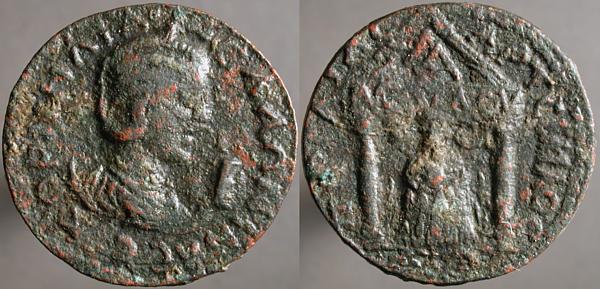
ΚΟΡΝΗΛΙΑ CΑΛΩΝΙΝΑ CΕ, Diademed draped bust right, on crescent, I before | ΠΕΡΓΑ[ΙΑC ΑΡΤ]ΕΜΙΔΟC, Distyle temple, simulacrum of Pergaean Artemis within, a torch to either side, star above left, crescent above right. Α at top of pediment, ΑCVΛΟV across it.
The same reverse as Sunday, but this time with an obverse for Salonina, Gallienus's wife. The reverse is better centered on this recent acquisition, which helped me to read the legend, which helped me better understand what it's saying, actually labelling the subject as the Pergaean Artemis, than when I had just the less well-centered example for Gallienus.
Monday, August 16, 2004
Strengthen The Good In Florida
Ways to help out in Florida at Strengthen The Good.
Silvered Æ antoninianus, Gallienus, Siscia, Göbl 1443i
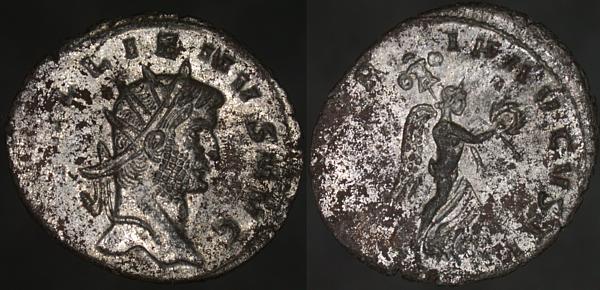
GALLIENVS AVG, Radiate head right | VICTORIA AVGVSTI, Victory advancing right, holding wreath before and trophy over shoulder.
I think this is one of the most handsome of all the imperial reverses for Gallienus and wish it photographed a bit better. The deteriorating surface silvering and the weakness of the strike on the left side of the coin work against that, though.
Göbl's book only attests two examples, one with this simple radiate head right, the other with a fancier military bust left, so I have no regrets about buying this unphotogenic example: while it's always possible that someone with find a cache of a couple hundred near-perfect examples, it's more likely that I'll never see another.
Sunday, August 15, 2004
Æ30, Perga in Pamphylia, Gallienus, SNG von Aulock 4732
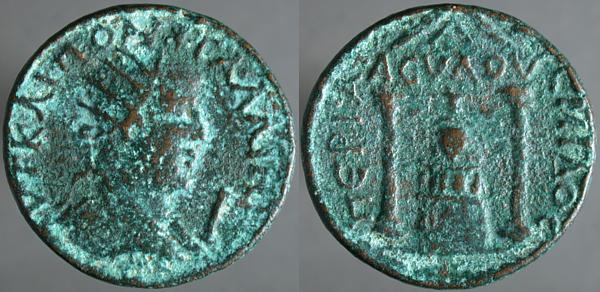
ΑVΤ ΚΑΙ ΠΟΑ[..] ΓΑΛΛΙΗ[...], Radiate draped bust right, I before | ΠΕΡΓΑ[ΙΑC ΑΡΤ]ΕΜΙΔΟC, Distyle temple, simulacrum of Pergaean Artemis within, a torch to either side, star above left, crescent above right. Α at top of pediment, ΑCVΛΟV across it.
In Monumental Coins, Marvin Tameanko suggests that ancient coins sometimes served as souvenirs for ancient tourists. His article that covers some of the same ground is here.
The Pergaean Artemis looks like a carved or otherwise ornamented baetyl, a meteorite held sacred. How it became associated with Artemis isn't clear, but it probably became a draw for those who wished to make requests of the goddess, or to honor vows made in her name.
This related coin features a smaller image of the temple between military standards, with a reverse legend that celebrates a temple of the cult of the imperial family.

